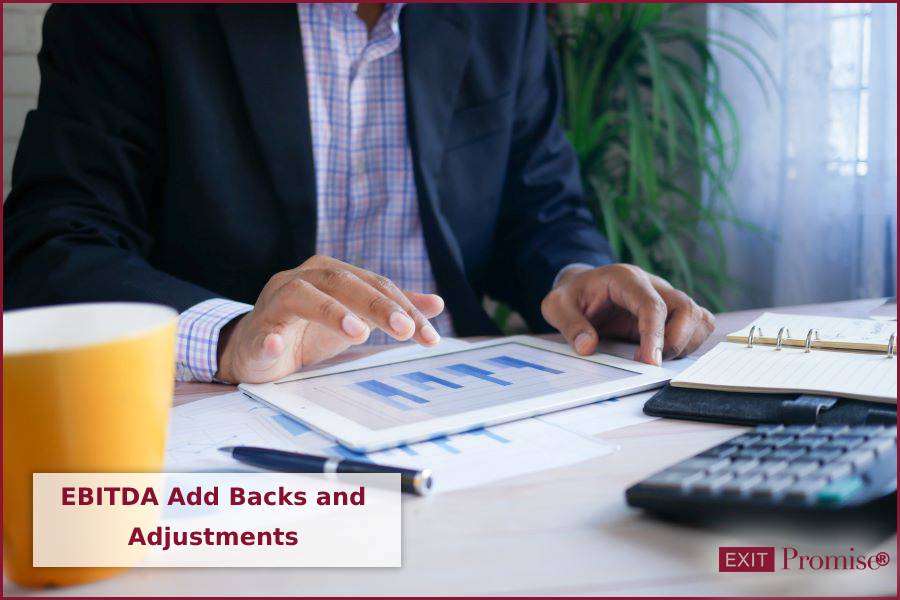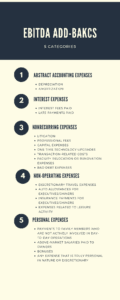- EBITDA Add Backs and Adjustments - February 20, 2023
- The Three Business Valuation Approaches [Infographic] - November 1, 2022
- The Negative Effect of Concentrations on the Value of a Business - August 17, 2022

Have a Question?
Ask your Question below!
One of our investors or advisors will answer.
Financial and investment professionals operating in the lower-middle market often use EBITDA as a key metric to analyze a company’s operating profitability and determine its value.
EBITDA is calculated by taking the company’s Earnings (E) and adding back Interest (I), Taxes (T), Depreciation (D) and Amortization (A). This post addresses non-customary addbacks, those which go beyond the company’s interest, tax, depreciation and amortization expenses, to calculate EBITDA.
A common method used to calculate business value involves applying a multiple to the company’s EBITDA. And while business owners who intend to sell their business have many options to increase the transaction multiple, one way to unlock value using this calculation is to identify other, non-customary “add-backs” to increase EBITDA.
What Are Add-Backs?
An EBITDA add-back is an expense that will not be included in the buyer’s future P&Ls for the company. Understanding and applying add-backs and other kinds of adjustments helps normalize a business’s earnings on a go-forward basis. This will give all parties a true understanding of the cash flow, and therefore, the true value of the company.
What Are the Different Kinds of Add-Backs?
EBITDA add-backs generally fall into one of the following categories: abstract accounting expenses, interest expense, plus nonrecurring, nonoperating, and personal expenses. Add-backs and adjustments will vary from company to company, but understanding these major categories is helpful in identifying potential increases to EBITDA, and thus business value.
It is important to understand these add-back categories more fully so as to be able to accurately identify EBITDA increases and ultimately a more complete value of your business. Add-backs are also key for a buyer to understand the full scope of financial benefits the current owner experiences.
Abstract Accounting Expenses
Abstract accounting expenses generally include depreciation and amortization. These are abstract expenses that appear on the business’s profit and loss statement, and while they are considered legitimate deductions for accounting purposes, they haven’t truly occurred during the year when EBITDA is being calculated (i.e., there is no actual movement of cash) and subsequently don’t affect the financial benefits derived during the year in question by the business owner. Adding back depreciation and amortization to compute EBITDA is a customary add-back.
Interest Expenses
How you choose to capitalize a business is completely at the discretion of the business owner and any related interest or late payment fees paid are also an expense that is added back to the net earnings when computing EBITDA. This add back is customary.
Nonrecurring Expenses
Nonrecurring expenses are expenses that are not expected to happen again and are outside of the ordinary course of business. Such expenses often result from one-time, extraordinary events. Some typical examples include:
- Litigation costs
- Professional fees
- Capital expenses
- One-time technology upgrades
- Transaction-related costs
- Facility relocation or renovation expenses
- Bad debt expenses
There is an important consideration here, and that is these expenses are indeed nonrecurring. Clearly, this leaves room for interpretation. For example, if your business is engaged in lawsuits year after year, and such lawsuits are expected to continue, it would be clearly inappropriate to add those costs back, as they are part of the ordinary course of business.
Non-operating Expenses
Non-operating expenses are add-backs expenses that are not required in, or related to the true operating performance of the company. Oftentimes, these are related to non-operating assets or liabilities, such as real estate or vehicles. Some typical examples include:
- Discretionary Travel expenses
- Auto allowances for executives and business owners
- Insurance payments for executives and business owners
- Expenses related to leisure activity
Non-operating expenses appear towards the bottom of the company’s income statement. As they do not directly correlate to the business. As such, they are considered an add-back to help the business appraiser or business valuation analyst focus more on the true value of the company.
Personal Expenses
Personal expenses are often expensed through a business to reduce tax liability. These expenses should be added back because they will end once the business is sold. Some typical examples include:
- Payments to family members who are not actively involved in the day-to-day operations of the business
- Above-market salaries paid to the owners or their relatives
- Bonuses serving as shareholder distributions
- Any expense that is truly personal in nature or discretionary
This category will also include discretionary expenses, such as charitable contributions and food and entertainment expenses. When adjusting for excess compensation, it is important to consider payroll taxes, insurance, and the benefits related to any excess wages.
Negative Add-Backs
Despite the name, EBITDA add-backs will not always increase the earnings of your business. Remember, the purpose of EBITDA add-backs is to reflect the true economic earning potential of a business if a third party owned it. Sometimes, negative add-backs are necessary for items that are expected to decrease earnings of the business going forward.
If the business owner personally owns the real property where the business is located and charges below-market rent, the rent expense should be increased to reflect the cost to new owners who will not have the same favorable rent. Or maybe the business owner does not intend to sell all the business’s assets as part of the transaction. In that case, any revenues associated with those assets should be removed to reflect the actual earning ability without those assets.
Factors to Consider
When accounting for add-backs, you will want to analyze the company’s P&Ls for the types of expenses and adjustments discussed above. Be careful not to miss one-time expenses that are easily overlooked. When putting together your add-backs, make sure each one is legitimate and is defendable.
In addition to the various types of add-backs and adjustments, different companies have different ones they must consider. An ESOP, for example, may have add-backs that would differ from a family-owned business.
In Conclusion
While adding back (or adjusting) EBITDA is valid in most settings, it’s not ideal to go to market for sale with a significant number of other, non-customary add backs. Generally speaking, when it comes to the number of EBITDA add backs, less is more. Buyers, Investors, PE firms and the like prefer fewer add-backs to EBITDA when considering their investment in your business.
That said, the inclusion of valid EBITDA add-backs create a clear picture of your business’s cash flow which makes it easier to understand how much your business is worth. Work with an experienced professional who thoroughly understands this process to ensure you properly compute EBITDA and ultimately receive the greatest value for your business.














How about commissions paid to Consultants for the sale of new business. The commission is paid first year only, no trails. Can I add those back? They seem to be similar to an acquisition. The full revenue goes on in the future but the commission is just FY.
Hi Brad,
I am a Business Broker advisor and member of EXIT Promise. Typically, I treat commissions paid for the sale of a business as addbacks. If these are non-recurring expenses that are only related to the sale of a business, they should be considered an addback.
I hope this helps.
What is the standard treatment of R&D expenses…EBITDA addback or no? Our company manufactures and sells exercise equipment. We have an engineering department (internal payroll) and engage with third-parties for outside engineering services when researching or developing new product offerings and supporting the current product portfolio.
Hi Marisa,
There is no hard and fast rule regarding whether Research and Development Expenses are EBITDA addbacks.
If the R&D Expenses were one time type of expenditure, the seller could easily argue it’s a valid addback.
If the R&D Expenses are ongoing, however not an expenditure a buyer would continue post-closing, you may be able to argue it’s a valid addback.
It truly depends on the circumstances!
All the best…
My client, husband and wife, own a regular C-corp and and Ltd.
Ltd owns major assets such as Helicopters that they would like to transfer to the C-corp.
The C-corp is a helicopter tour operator. Ltd holds three helicopters and leases them to the C-corp which conducts aerial tourism.
The owners would like to move the helicopters to the C-corp from the Ltd, and desire to sell the C-corp.
Is the transfer of the helicopters away from the Ltd to the C-corp a taxable event?
Thank you.
Jacques:
The transfer could be taxable if there is gain in partnership (I assume that’s what you mean by “ltd”). Doesn’t have to be, though, depending on how you structure the transaction. Don’t know why you would want to this, though.
C-Corp could absorb the Partnership, or could just sell two separate businesses.
An interesting situation. Owners of and S-Corp believe that “Shareholder distribution” in cash qualify as add back towards recating EBITDA”. I am opposed to this of course. Shareholder distribution is a balance sheet item which involves retained earning and equity. Shareholder distribution is not an P&L expense.
Your comments would be very appreciated. Thank you
Jacques:
You are exactly right. S/h distribution is NOT part of the income or earnings statement. It’s not a deduction therefore you shouldn’t add it back!
Certain investments that could be capitalized – for simplicity, many private business owners record the investment in certain capital items as expenses on their income statement. Office equipment, software, and many repairs that could qualify for capitalization treatment are often expensed by sellers. This treatment has the effect of reducing reported income, which results in lower EBITDA and taxes. It is common to recast these expenditures as fixed assets, which increases EBITDA.
My client expensed all capital expenditures. He did not capitalize them. The P&L’s for 3 years show those capital expenditures as operating expenses. I want to recast these expenditures as fixed assets. To me this mean (1) depreciation and (2) remove those capital expenditures listed as operating in the P&L in order to enhance valuation,
Am I on the right track? Many thanks!
Jacques:
If you are trying to calculate EBITDA (D=Depreciation), then yes, you would back out all capital expenditures. Chances are, the maker of this original financial statement did it to match tax returns or to create them.
Once you back out the Fixed Assets, then you only have to remove interest and income taxes to get the EBITDA number.
To get a modified income statement, you would add back the depreciation on those assets. For a small business, depreciation=original cost of the assets in most cases because of the 100% Bonus depreciation rules which allowed most assets to be expensed in the year of purchase which is likely why the original reports were set up like they were.